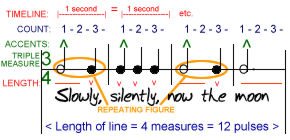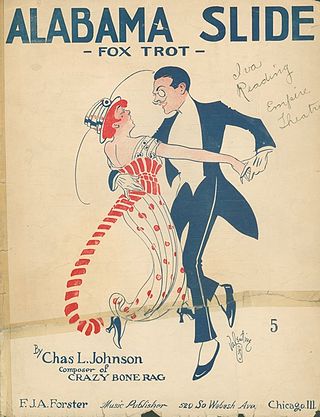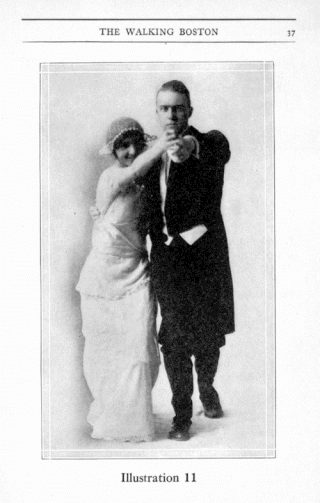
Ballroom dance is a set of partner dances, which are enjoyed both socially and competitively around the world, mostly because of its performance and entertainment aspects. Ballroom dancing is also widely enjoyed on stage, film, and television.
In music, syncopation is a variety of rhythms played together to make a piece of music, making part or all of a tune or piece of music off-beat. More simply, syncopation is "a disturbance or interruption of the regular flow of rhythm": a "placement of rhythmic stresses or accents where they wouldn't normally occur". It is the correlation of at least two sets of time intervals.

The waltz, meaning "to roll or revolve") is a ballroom and folk dance, normally in triple, performed primarily in closed position.

Ice dance is a discipline of figure skating that historically draws from ballroom dancing. It joined the World Figure Skating Championships in 1952, and became a Winter Olympic Games medal sport in 1976. According to the International Skating Union (ISU), the governing body of figure skating, an ice dance team consists of one woman and one man.

In music, metre or meter refers to regularly recurring patterns and accents such as bars and beats. Unlike rhythm, metric onsets are not necessarily sounded, but are nevertheless implied by the performer and expected by the listener.
Dance moves or dance steps are usually isolated, defined, and organized so that beginning dancers can learn and use them independently of each other. However, more complex movements are influenced by musicality and lyrical relevance to express emotions or refer to a message. Dance moves tend to emphasize the concepts of lead and follow and connection.

Viennese waltz is a genre of ballroom dance. At least four different meanings are recognized. In the historically first sense, the name may refer to several versions of the waltz, including the earliest waltzes done in ballroom dancing, danced to the music of Viennese waltz.

Salsa is a Latin dance, associated with the music genre of the same name, which was first popularized in the United States in the 1960s in New York City. Salsa is a mixture of Cuban dances, such as mambo, pachanga, and rumba, as well as American dances such as swing and tap.

The foxtrot is a smooth, progressive dance characterized by long, continuous flowing movements across the dance floor. It is danced to big band music. The dance is similar in its look to waltz, although the rhythm is in a 4
4 time signature instead of 3
4. Developed in the 1910s, the foxtrot reached its height of popularity in the 1930s and remains practiced today.

A redowa is a dance of Czech origin with turning, leaping waltz steps that was popular in European ballrooms.
This is a list of dance terms that are not names of dances or types of dances. See List of dances and List of dance style categories for those.

The Walking Boston, sometimes designated the One Step Waltz, is a very simple dance in which many graceful figures may be introduced. It is done to the same music as the Hesitation Waltz and Dream Waltz.

The cha-cha-cha, is a dance of Cuban origin. It is danced to the music of the same name introduced by the Cuban composer and violinist Enrique Jorrin in the early 1950s. This rhythm was developed from the danzón-mambo. The name of the dance is an onomatopoeia derived from the shuffling sound of the dancers' feet when they dance two consecutive quick steps that characterize the dance.

Bulgarian folk dances are intimately related to the music of Bulgaria. This distinctive feature of Balkan folk music is the asymmetrical meter, built up around various combinations of 'quick' and 'slow' beats. The music, in Western musical notation, is often described using compound meter notation, where the notational meter accents, i.e., the heard beats, can be of different lengths, usually 1, 2, 3, or 4. Many Bulgarian dances are line dances, in which the dancers dance in a straight or curved line, holding hands.
The country/western two-step, often called the Texas two-step or simply the two-step, is a country/western dance usually danced to country music in common time. "Traditional [Texas] two-step developed, my theory goes, because it is suited to fiddle and guitar music played two-four time with a firm beat [found in country music]. One-two, one-two, slide-shuffle. The two-step is related to the polka, the Texas waltz, and the jitterbug.
The Texas two-step is the same step known to ballroom dancers as the international fox-trot. Except for the one-step, which is just that, most Texas dances are variations of a two-step, also called a half-step, which is simply a step-close-step. The Texas two-step is generally done with two long steps and a step-close-step to two-four time. Speeded up, it's a shuffle or double shuffle, but still a two-step.
The hambo is a traditional dance that originated in Sweden in the late 19th and early 20th centuries. It is a couple dance in 3
4 time, danced to music played with a strong accent on the first beat and a tempo that varies from moderate to fast. The hambo is a dance with a fixed pattern and tunes almost always have a corresponding eight measure structure.
Zydeco as a dance style has its roots in a form of folk dance that corresponds to the heavily syncopated zydeco music, originated in the beginning of the 20th century among the Francophone Creole peoples of Acadiana. It is a partner dance that has been primarily danced socially and sometimes in performances.
Valse à deux temps, waltz à deux temps, also Valse à deux pas or Valse Russe was a waltz of Russian origin introduced in France in the mid-19th century.
Pravo horo is a very popular, simple folk dance from Bulgaria that is done throughout the Balkan countries. In Greece, it is called Zonaradiko. It is considered the "national dance" of Bulgaria, Albania, and North Macedonia. It is a rustic village line dance with a three-measure pattern, done to 2
4 or 6
8 music, and is a staple of weddings, feast days, and other celebrations. As with other Balkan dances, each country and even local region has its own variation of the dance, often interspersing other steps with the basic pravo step, to the extent that these different versions amount to distinct dances.











